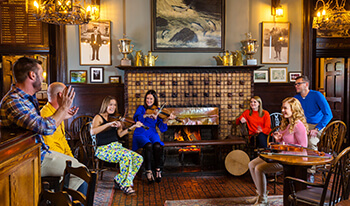Kilkenny Castle (Irish: Caisleán Chill Chainnigh) is a castle in Kilkenny, Ireland. It was the seat of the Butler family. Formerly the family name was FitzWalter. The castle was sold to the local Castle Restoration Committee in the middle of the 20th century for £50. Shortly afterward it was handed over to the State, and has since been refurbished and is open to visitors. Part of the National Art Gallery is on display in the castle. There are ornamental gardens on the city side of the castle, and extensive land and gardens to the front. It has become one of the most visited tourist sites in Ireland.
Kilkenny castle was the venue for the meeting of the General Assembly, or parliament, of the Confederate Ireland government in the 1640s.
Awards and conferring ceremonies of the graduates of "Kilkenny Campus" of National University of Ireland, Maynooth have been held at the castle since 2002.
The present castle is located on a prominent vantage point at a bend in the River Nore. This strategic site was where the local kings, the O'Carrolls (840 AD), O’Dunphys and Fitzpatricks, had their castle(s) before the Norman invasion. Richard de Clare (also known as Strongbow) built the first Norman tower on the site in 1172. Twenty years later, de Clare's son-in-law, William Marshal, Earl of Pembroke, built the first stone castle on the site, of which three towers still remain. The entrance was through the (now missing) east wall. Various other features of the original castle have also been excavated, including original stone buttressing and a garderobe.
Rear view of the castleThe Butler family arrived in Ireland with the Norman invasion, changing their name from Walter in 1185. The castle was owned by the seneschal of Kilkenny Sir Gilbert De Bohun who inherited the county of Kilkenny and castle from his mother in 1270, in 1300 he was outlawed by Edward I but was reinstated in 1303, he held the castle until his death in 1381. It was not granted to his heir Joan, but seized by the crown and sold to the Butler family. By 1391, the family had become wealthy, and James Butler, 3rd Earl of Ormonde, bought the castle and established himself as ruler of the area. The Butler dynasty then ruled the surrounding area for centuries.
In the 17th century, the castle came into the hands of Elizabeth Preston, wife of then Lord Lieutenant of Ireland, another James Butler, also 12th Earl and 1st Duke of Ormonde. Butler, unlike most of his family, was a Protestant and throughout the Irish Confederate Wars of the 1640s was the representative of Charles I in Ireland. However, his castle became the capital of a Catholic rebel movement, Confederate Ireland, whose parliament or "Supreme Council" met in Kilkenny Castle from 1642-48. Ormonde himself was based in Dublin at this time. The east wall and the northeast tower of the Castle were damaged in 1650 during the siege of Kilkenny by Oliver Cromwell during the Cromwellian conquest of Ireland. They were later torn down. Then, in 1661, Butler remodelled the castle as a “modern” château after his return from exile. A new entrance gateway in the south wall was built around this time.
The castle seen from the nearby River Nore.By the 18th century, the castle had become run down, reflecting the failing fortunes of the Butler family. However, some restoration was carried out by Anne Wandesford of Castlecomer, who brought wealth back into the family upon marrying John Butler, 17th Earl of Ormonde.
In the 19th century, the Butlers then attempted to restore it to its original medieval appearance, also rebuilding the north wing and extending the south curtain wall. More extensions were added in 1854.
During the Irish Civil War in 1922, Republicans were besieged in the Castle by Irish Free State forces. The Ormondes, together with their pet Pekinese, chose to remain in situ in their bedroom over the great gate, which was the main focus of attack. There was a machine gun outside their door. One man was injured but a great deal of damage was inflicted on the castle, which took many years to repair.
The Butler family remained living in the castle until 1935, when they sold its contents for £6,000, moved to London, and abandoned it for thirty years. The impact of rising taxes, death duties, economic depression and living costs had taken their toll. While the Ormondes had received £22,000 in rental income in the 1880s, investment income in the 1930s was in the region of £9,000 and by 1950 these investments yielded only £850. They disposed of the bulk of their tenanted estates in Tipperary and Kilkenny, 21,000 acres (85 km²), by 1915 for £240,000. Death duties and expenses following the death of James Butler, 3rd Marquess of Ormonde in 1919 amounted to £166,000.
View from the river, 1841In 1967, Arthur Butler, 6th Marquess and 24th Earl of Ormonde, sold the abandoned and deteriorating castle to the Castle Restoration Committee for £50, with the statement: "The people of Kilkenny, as well as myself and my family, feel a great pride in the Castle, and we have not liked to see this deterioration. We determined that it should not be allowed to fall into ruins. There are already too many ruins in Ireland." He also bought the land in front of the castle from the trustees "in order that it should never be built on and the castle would be seen in all its dignity and splendour". Mick Jagger and Marianne Faithfull turned up at the castle hand over party, with Jagger telling the newspapers "We just came to loon about."
The rest of the 20th century saw a large amount of restoration and maintenance take place, as well as the castle being opened to visitors. The Butler Gallery, in the castle basement, holds rotating exhibitions put on by the Kilkenny Art Gallery Society in a venue named for Peggy and Hubert Butler.




















